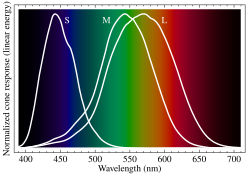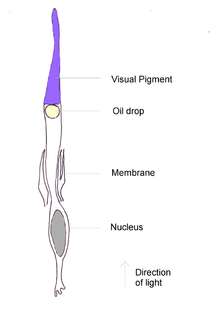Cone cell
| |||||||||||||||||||||||
Read other articles:

Ethnic Arabs who adhere to Islam Arabs who follow Islam Arab Muslimsﺍﻟْمُسْلِمﻴُّﻮﻥ ﺍﻟْﻌَﺮَﺏPopulation of Arab MuslimsRegions with significant populations Arab LeagueLanguagesArabicReligionSunni Islam (majority)Shia Islam (minority)Related ethnic groupsArab Christians and other Arabs Part of a series onArabic culture ArchitectureStyles Islamic Yemeni Nabataean Umayyad Abbasid Fatimid Moorish Mamluk Features Ablaq Alfiz Arabesque Arabic dome Banna'i…

Election for Lieutenant Governor of Minnesota 1950 Minnesota lieutenant gubernatorial election ← 1948 November 7, 1950 1952 → Nominee C. Elmer Anderson Frank Murphy Party Republican Democratic (DFL) Popular vote 588,777 401,148 Percentage 58.35% 39.76% County resultsAnderson: 40-50% 50-60% 60-70% 70-80%Murphy: 40-50…

Thé sombrethé noir-noir Le thé Pu'er, originaire du Yunnan, est le thé sombre le plus consommé dans le monde. Pays d’origine Chine Type thé post-fermenté Degré d'alcool 0° modifier Thé sombre Nom chinois Chinois 黑茶 Traduction littérale thé noir Transcription Mandarin - Pinyin hēichá Min - Hokkien POJ hek-tê Nom alternatif Chinois traditionnel 後發酵茶 Chinois simplifié 后发酵茶 Traduction littérale thé post-fermenté Transcription Mandarin - Hanyu pin…

Pulp magazine This article is about the pulp magazine. For comic strip Secret Agent X-9, see Secret Agent X-9. Comics character Secret Agent XCover of Secret Agent Magazine for April 1937 showing inclusion of story about Secret Agent X.Publication informationPublisherAce MagazinesFirst appearanceSecret Agent X #1Created byPaul ChadwickIn-story informationAlter egoUnknownSupporting character ofBetty DaleJim HobartHarvey BatesThaddeus PennyAbilitiesGenius-level intellect, expert knowledge of physi…

Albert Louis Emmanuel de Fouler de Relingue Le général Albert Louis Emmanuel de Fouler. Naissance 9 février 1770[1]Lillers, Pas-de-Calais Décès 13 juin 1831 (à 61 ans)Ancien 2e arrondissement de Paris Origine Française Arme Cavalerie Grade Général de division Années de service 1786 – 1815 Conflits Guerres de la Révolution françaiseGuerres napoléoniennes Distinctions Comte de l'EmpireChevalier de Saint-LouisGrand officier de la Légion d'honneur Hommages Nom gravé sous l'arc …

Farfa, pseudonimo di Vittorio Osvaldo Tommasini (Trieste, 10 dicembre 1879 – Sanremo, 20 luglio 1964), è stato un pittore, poeta e fotografo italiano. Vittorio Osvaldo Tommasini (primo a sinistra) in visita alla Manifattura ceramiche Giuseppe Mazzotti alla fine degli anni '20 del XX secolo. Indice 1 Biografia 2 Opere 2.1 Poesia 2.2 Teatro 2.3 Raccolte 3 Farfa o Vittorio Osvaldo Tommasini nei musei 4 Note 5 Bibliografia 5.1 Raccolte ed edizioni postume 5.2 Opere critiche 5.3 Mostre e cataloghi…
周處除三害The Pig, The Snake and The Pigeon正式版海報基本资料导演黃精甫监制李烈黃江豐動作指導洪昰顥编剧黃精甫主演阮經天袁富華陳以文王淨李李仁謝瓊煖配乐盧律銘林孝親林思妤保卜摄影王金城剪辑黃精甫林雍益制片商一種態度電影股份有限公司片长134分鐘产地 臺灣语言國語粵語台語上映及发行上映日期 2023年10月6日 (2023-10-06)(台灣) 2023年11月2日 (2023-11-02)(香港、…

CavrianaKomuneComune di CavrianaNegaraItaliaWilayahLombardyProvinsiMantua (MN)FrazioniBande, Campagnolo, Castelgrimaldo, San Giacomo, San Cassiano grimaldoPemerintahan • Wali kotaBruno RighettiLuas • Total36,8 km2 (142 sq mi)Populasi (June 2008)[1] • Total3.880 • Kepadatan11/km2 (27/sq mi)Zona waktuUTC+1 (CET) • Musim panas (DST)UTC+2 (CEST)Kode pos46040Kode area telepon0376Situs webSitus web resmi Cavri…

此条目序言章节没有充分总结全文内容要点。 (2019年3月21日)请考虑扩充序言,清晰概述条目所有重點。请在条目的讨论页讨论此问题。 哈萨克斯坦總統哈薩克總統旗現任Қасым-Жомарт Кемелұлы Тоқаев卡瑟姆若马尔特·托卡耶夫自2019年3月20日在任任期7年首任努尔苏丹·纳扎尔巴耶夫设立1990年4月24日(哈薩克蘇維埃社會主義共和國總統) 哈萨克斯坦 哈萨克斯坦政府與�…

2017 film by John Curran ChappaquiddickTheatrical release posterDirected byJohn CurranWritten byTaylor AllenAndrew LoganProduced byMark CiardiChris CowlesCampbell G. McInnesStarringJason ClarkeKate MaraEd HelmsJim GaffiganClancy BrownOlivia ThirlbyBruce DernCinematographyMaryse AlbertiEdited byKeith FraaseMusic byGarth StevensonProductioncompanyApex EntertainmentDistributed byEntertainment Studios Motion PicturesRelease dates September 10, 2017 (2017-09-10) (TIFF) April 6…

لمعانٍ أخرى، طالع حاشد (توضيح). حاشد (خط المسند: ) قبيلة يمنية قديمة من قبائل همدان وأقدم ذكر يشير إليها يعود للقرن الرابع قبل الميلاد.[1] هي أكثر القبائل نفوذاً سياسيا في الجمهورية اليمنية منذ سقوط الملكية عام 1962 وبعد الوحدة اليمنية[2] تشكل هي وقبائل بكيل قسمي قبا…

For Blue Haze, the British pop reggae studio group, see Johnny Arthey. 1956 compilation album by Miles DavisBlue HazeCompilation album by Miles DavisReleasedEarly October 1956[1]RecordedMay 19, 1953, March 15 and April 3, 1954StudioWOR (New York City)Van Gelder (Hackensack)GenreJazz, bebop, hard bopLength36:33LabelPrestige PRLP 7054ProducerBob Weinstock, Ira GitlerMiles Davis chronology Quintet/Sextet(1956) Blue Haze(1956) Collectors' Items(1956) Professional ratingsReview scores…

BRP Cape Engaño (MRRV-4411) History Philippines NameBRP Cape Engaño NamesakeCape Engaño Lighthouse located in Palaui Island, Santa Ana, Cagayan Ordered29 May 2015 BuilderJapan Marine United, Yokohama, Japan CompletedJuly 2018 Commissioned23 August 2018 Identification IMO number: 9809514 MMSI number: 548928500 Callsign: 4DFU3 Hull number: MRRV-4411 Statusin active service General characteristics Class and typeParola-class patrol vessel Length44.5 m (146 ft) Beam7.5 m (…

Supercomputer ASCI RedActiveTwo-Thirds Operational March 1997, Fully Operational June 1997,[1] decommissioned 2006[2]SponsorsIntel Corporation[1]OperatorsSandia National Laboratories, US Department of EnergyLocationSandia National Laboratories, United StatesPower850 kWOperating systemCougar / TOS (a Mach kernel derivative)Space1,600 sq ft (150 m2)[3]Memory1212 gigabytesSpeed1.3 teraflops (peak)[1]RankingTOP500: 1, June 2000[4]Pur…

Issuer of exchange-traded funds ProSharesIndustryFinancial servicesFoundedProFunds Group: 1997; 27 years ago (1997)ProShares: 2006; 18 years ago (2006)FoundersLouis MaybergMichael SapirHeadquartersBethesda, MarylandProductsExchange-traded fundsAUMUS$70 billion (2024)[1]Websitewww.proshares.com// ProShares is an issuer of exchange-traded funds, including inverse exchange-traded funds, and similar products.[2] History ProFunds Group was founded i…

Grassy ground on which the game of cricket is played A standard cricket field, showing the cricket pitch (brown), close-infield (light green) within 15 yards (14 m) of the striking batsman, infield (medium green) inside the white 30 yards (27 m) circle, and outfield (dark green), with sight screens beyond the boundary at either end. A perspective view of the cricket pitch from the bowler's end. The bowler runs in past one side of the wicket at the bowler's end, either 'over' the wicket…

ويكيبيديا الكانتونيزيةالشعارمعلومات عامةموقع الويب zh-yue.wikipedia.org (الصينية اليؤوية) تجاري؟ لانوع الموقع موسوعة حرةالتأسيس 25 مارس 2006 الجوانب التقنيةاللغة الكانتونيةترخيص المحتوى رخصة المشاع الإبداعي الملزِمة بالنسب لمؤلِّف العمل وبالترخيص بالمثل غير القابلة للإلغاء 3.0 — ر�…

Bellinzona municipality of Switzerland (en) cantonal capital of Switzerland (en) city of Switzerland (en) Tempat NegaraSwissDaftar kanton di SwissKanton TicinoDistrict of the canton of Ticino (en) Bellinzona District (en) Subdistrict of the canton of Ticino (en) Subdistrict Bellinzona (en) Ibu kota dariKanton Ticino Bellinzona District (en) Canton of Bellinzona (en) Q20723174 (1503–1798) NegaraSwiss PendudukTotal43.785 (2023 )Bahasa resmiItalia GeografiLuas wilayah164,96 km² [c…

لمعانٍ أخرى، طالع هاميلتون (توضيح). هاميلتون (جزر برمودا) (بالإنجليزية: Hamilton) خريطة الموقع تاريخ التأسيس 1793 تقسيم إداري البلد برمودا [1][2] عاصمة لـ برمودا (1815–) التقسيم الأعلى برمودا خصائص جغرافية إحداثيات 32°17′42″N 64°46′59″W / 32.295�…

RighteousAmong the Nations The Holocaust Rescuers of Jews Righteousness Seven Laws of Noah Yad Vashem By country Austrian Croatian German Hungarian Lithuanian Norwegian Polish (list) Romanian Serbian Ukrainian vte As of 1 January 2022[update], Yad Vashem recognised 651 Righteous Among the Nations from Germany.[1][2][3] Contents A B C D E F G H I J K L M N O P Q R S T U V W X Y Z A Elisabeth Abegg (1882–1974), recognised 1967 Willi Ahrem (1902–1967), …



